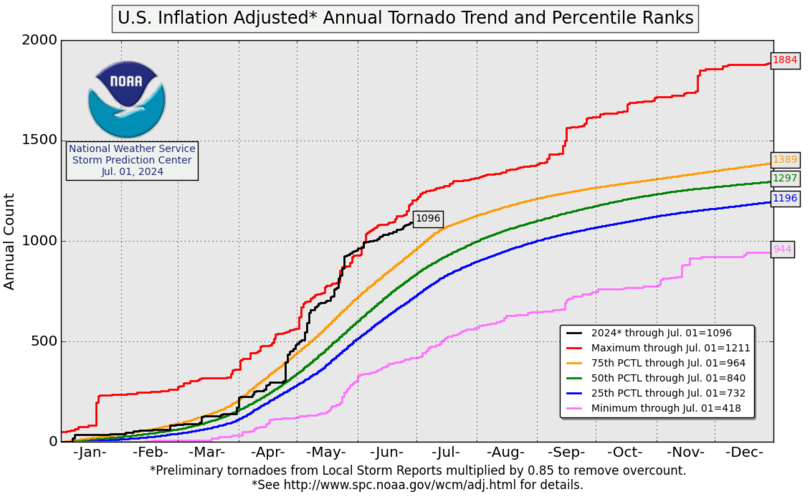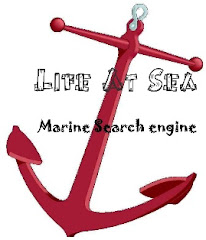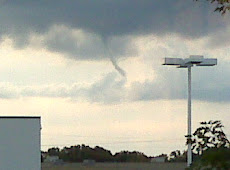 NOAA Satellites Help Save 23 People in the North Atlantic
NOAA Satellites Help Save 23 People in the North AtlanticApril 11, 2008
In a dramatic distress case yesterday, NOAA satellites helped the U.S. Coast Guard respond to a major engine room fire aboard the merchant vessel M/V Sea Venus 1,200 miles east of Cape Cod, Mass.
The 577 foot Panamanian-flagged vessel, with a crew of 23, was en route from Rhode Island to Belgium when the fire broke out. At about 7:30 a.m., NOAA’s satellites detected a distress signal from an emergency position indicating radio beacon (EPIRB) onboard the vessel and relayed the ship’s location to search and rescue personnel at the Coast Guard’s Rescue Coordination Center (RCC) in Norfolk, Va. The Canadian Navy, and two other merchant vessels in the area, also provided critical coordination.
NOAA’s polar-orbiting and geostationary satellites are part of the international Search and Rescue Satellite-Aided Tracking System called COSPAS-SARSAT. This system uses a network of satellites to quickly detect and locate distress signals from emergency beacons onboard ships and aircraft and from handheld personal locator beacons.
“Yesterday’s incident was a tragedy averted,” said Chris O’Connors, acting program manager for NOAA SARSAT.
In Canada, personnel based at RCC Halifax contacted the Coast Guard at the RCC in Norfolk that they established voice communication with the Sea Venus' crew, who initially reported the engine room fire had been extinguished with the ship's automatic CO2 systems and no assistance was needed.
But rescue officials received a second distress call from the ship that the fire had re-flashed, the CO2 system had been depleted, and the crew was fighting the blaze with water and hand-held extinguishers. After regaining control and finally extinguishing the fire, fourteen of the 23 crew members were then safely transferred from the Sea Venus to its sister ship, the Olympian Highway. Nine crew members remain onboard to await a tug from Halifax that is scheduled to arrive on Sunday.
“The SARSAT program worked as designed, especially with the international coordination and teamwork between the U.S. and Canada,” O’Connors said.
Now in its 26th year of operation, COSPAS-SARSAT has been credited with more than 22,000 rescues worldwide, including more than 5,800 in the United States and its surrounding waters.
NOAA is dedicated to enhancing economic security and national safety through the prediction and research of weather and climate-related events and information service delivery for transportation, and by providing environmental stewardship of our nation's coastal and marine resources. Through the emerging Global Earth Observation System of Systems (GEOSS), NOAA is working with its federal partners, more than 70 countries and the European Commission to develop a global monitoring network that is as integrated as the planet it observes, predicts and protects.
WEATHER NOTECommon Myths About Driving in Dangerous Weather
Prevent Yourself From Making Wrong Decisions During Dangerous Conditions
By JOY CIARCIA-LEVY
April 15, 2008—
You never know where you'll be when severe weather strikes. You could even be in your car. So, when driving gets hazardous, we rely on habit, and tried and true techniques. But how true are they?
Myth #1: You Can Dodge an Oncoming Tornado in Your Car
Let's say you're driving and encounter a tornado. The first reaction of many people is amazement at nature's fury. But then reality sets in, maybe panic. People need to make a split-second decision about what to do. Too often they decide they can outrun the tornado in their car. But automotive expert and former race car driver Lauren Fix says that is pure myth.
"Tornadoes change direction without any notice and you don't know what the road in front of you is gonna look like," Fix said. "There could be debris. You could have a roadway that's blocked. Where are you gonna go?"
"But I've seen this," ABC News' Sam Champion said. "I've seen people in cars out-drive tornadoes."
"You've seen the storm chasers," Fix replied. "These people are professionals and this is not something the average driver should even attempt."
The best advice, Fix said, is "if you see a tornado, find shelter immediately. Your car is a 4,000 pound toy and it can be tossed at anywhere, anytime."
Myth #2: Steer into the Skid
The winter season is filled with myths about snow, ice and freezing temperatures. So, what better place to get to the cold hard truth than about 9,000 feet up in the Colorado Rockies, where places like Steamboat Springs can get 30 feet of snow in a winter season, and it rarely gets above freezing.
That's great for the ski conditions, but for driving ... well, that's something completely different, as Mark Cox of the Bridgestone Winter Driving School knows firsthand.
"If you start to skid on the ice or snow, just realize that it's not the end of the world," he said. "First and foremost, don't panic."
Normally, Cox said, people react by letting go of the steering wheel, yanking on it or jamming on the brakes. "None of these things helps you in correcting a skid," he said.
We're often told to steer into a skid. But is that the right thing to do?
Let's say you turn a corner in the snow or ice, and the car skids. You realize the front end is turning to the right. Many people would believe 'steering into the skid' means turning the car to the right ... big mistake! This is an over-steering situation in which the skid actually happened because the rear wheels skidded to the left. So, if you were to steer into the skid, you'd be steering to the left. But this can get confusing, so Cox tells students, instead of steering into the skid, "Look in the direction that you'd rather have the car be going, and steer that way."
CLICK HERE to see an explanatory diagram from the Bridgestone Winter Driving School.
Myth #3: Always Warm Up Your Car
Another winter driving myth: always warm up the car. But this one simply isn't true. Cox explains that "modern cars deal really well with cold. And you can start it up pretty quickly, and take off right away, within thirty seconds, and it's fine."
In fact, experts say idling the car wastes gas, and that's bad for the environment.
Myth #4: You Can Drive Through a Flooded Roadway
After winter snows, drivers have to deal with April showers. So, if torrential rains flood the roads, don't buy into the myth that you can drive right through, even if you think it's just a puddle. Fix warned, "if it's flooded roadways from a river, a creek, or a lake, you do not want to drive through it because anything that's even a foot deep of water, which is not much at all, can cause your vehicle to float."
Champion's advice to drivers is to "slow down and make a good solid judgment about where the water's coming from, how much water do I think it is before I pursue."
Myth #5: Your Car Provides Protection From Lightning
Those April showers also bring something else ... lightning, and the myth people continue to believe, no matter what they've been told: you're safe in your car if you get struck by lightning because of the rubber in the tires.
Fix said that people believe the rubber in their tires acts as an insulator that will keep them safe from the lightning. But in reality, he said, "if you get struck by lightning, it will travel down to the ground and stop itself. But you will hear a loud bang inside the car, and it's very scary."
The popular British TV show "Top Gear" put this myth to the test with host Richard Hammond as the guinea pig.
"They're going to zap me and this car with 800,000 volts," Hammond said to the cameras during the demonstration. "You might think the tires are going to protect me, by insulating the car from Earth because they're rubber."
Inside the car, he waited and then suddenly, Hammond said, "I'm being hit by lightning!"
He quickly realized, "now it's doing stuff to the car, got error message up on the dashboard."
After the ordeal, Hammond was thankful, yet amazed, to say, "I'm alive."
It wasn't the tires that kept Hammond safe. As this experiment proved, the one thing that will protect you from a lightning strike is your car's metal frame, because the electricity travels around the passenger compartment and down to the ground.
But what happened to the car?
To Hammond's surprise, "it starts, it still works, amazing."
But not everyone is so lucky.
"My poor little car was totaled," said Wendy Allen, a graduate student at the University of Florida, who was struck by lightning as she drove on a rural Mississippi highway a few years ago.
"It was raining very heavily, it was thundering and lightning, and I just saw bright light," she said. "Intense light filled up my car for just a split second. But it was a deafening bang."
Her car antenna was destroyed because that's where the lightning hit, and a tiny scorch mark on the trunk showed where the lightning exited after it fried the car's electrical system. It wasn't the car's rubber tires that protected Allen. It's because she wasn't touching anything metal in the car.
And that, Fix said, is the best advice if you get caught in your car in a thunder storm.
"In the vehicle, there's a lot of plastic and a lot of non-metal components," he said. "Best thing is don't touch anything metal. Keep your hands ... to yourself. Pull over and park in a safe place, if you can. It's absolutely safer to stay in the car than get out of the car."
At the end of the day, Allen admitted, "there is not a doubt in my mind that I'm incredibly lucky to be alive today. My car saved my life."
National Level Exercise Begins In May
Release Date: April 24, 2008
Release Number: HQ-08-063
WASHINGTON, D.C. -- The Department of Homeland Security's Federal Emergency Management Agency (FEMA) National Exercise Program (NEP) will conduct National Level Exercise 2-08 (NLE 2-08) a combined functional and full scale exercise from May 1 through May 8. NLE 2-08 will merge the objectives of U.S. Northern Command's (NORTHCOM) Ardent Sentry 2008 exercise, FEMA National Continuity Program's (NCP) Eagle Horizon 2008 exercise (formerly known as Forward Challenge), and FEMA Disaster Operation's Hurricane Preparedness Exercise (HPE).
The purpose of NLE 2-08 is to exercise national capabilities to prepare and respond to multiple incidents including both natural disasters and terrorist incidents. The exercise was designed to include scenario elements addressing hurricane preparedness and response, national continuity capabilities, and Defense Support to Civil Authorities coordination in response to weapons of mass destruction terrorist attacks. The exercise venues involve a Category 4 hurricane impacting the Mid Atlantic Coast and the National Capitol Region and multiple terrorist attacks in Washington State.
Also during NLE 2-08, the Chemical Stockpile Emergency Preparedness Program (CSEPP) will test it's response to an accidental chemical agent release at the Umatilla Chemical Depot in Oregon. Canada will also participate through their Staunch Maple Exercise.
The exercise allows Federal officials to implement continuity plans, test communications connectivity, operations and procedures for performing essential government functions from alternate locations, and interagency coordination. Additionally, it serves to demonstrate that essential functions can be effectively conducted during threats and emergencies.
NLE 2-08 is a NEP exercise conducted within the five year exercise schedule. The NEP is the nation's overarching homeland security exercise program, provides the federal government with a national, interagency wide program and a multi-year planning system to focus, coordinate, plan, conduct, execute, evaluate and prioritize national security and homeland security preparedness-related exercise activities.
FEMA coordinates the federal government's role in preparing for, preventing, mitigating the effects of, responding to, and recovering from all domestic disasters, whether natural or man-made, including acts of terror.
Disaster experts’ advice: Be prepared
Brad ShannonDisaster-response experts still are drawing lessons from December's flooding that killed a half-dozen people in Washington and caused millions of dollars in damage.
The storms that flooded the Chehalis River basin also forced hundreds of families out of homes. Community groups have received a stream of donations to help victims; United Way of Lewis County alone raised more than $1.1 million.
The single-largest donation came from Olympia-based The Community Foundation of South Puget Sound, which gave nearly $155,000 through two relief funds, executive director Norma Schuiteman said. But the needs are larger than the help, three experts told the foundation's annual meeting in Olympia on Wednesday.
"I figure per capita damages were about $500 per person in Mason County," Martin Best, Mason County emergency management manager, told the crowd of about 85 at Indian Summer Golf & Country Club.
Federal aid to individuals totaled a little more than $1 million, Best said, so "right there we're facing close to a $10 million shortfall for individuals affected by this disaster."
"We ended up taking in more than seven tons of clothing. That actually became the second disaster," said Debbie Campbell, director of United Way of Lewis County, whose efforts at storage were hampered by flooded buildings. "I would recommend you learn how to deal with that."
Be ready
Best, Campbell, and Thurston County Emergency Management director Kathy Estes carried a kindred message: Government and aid groups cannot do it all, and individuals need to be ready for the first days of the next bad storm or earthquake.
"How prepared are you? Are you really ready to spend a week without being able to get to the store? And I encourage you to be. Many people locally found that was a reality for them," Estes said. "Each individual really needs to take care of themselves and their families."
Best said residents should have an out-of-state phone number that family members can call in an emergency, so messages can be relayed among relatives when local phone connections break down.
The foundation distributed its aid through two funds — the Community Foundation Relief Fund and the Boistfort Valley Flood Relief Fund.
Campbell said about 400 Lewis County residents still are waiting to get back into their homes. In Thurston County, nearly 30 families still are rebuilding near the river, said Marcee Stiltner of Rochester Organization of Friends Community Services.
This video was taken by my friend Michael Hester in Portsmouth, Virginia during the Tornado that destroyed the neighborhoods in the nearby city of Suffolk
RS










 A tugboat was used to move a barge that overturned in Johnstone Strait last August.
A tugboat was used to move a barge that overturned in Johnstone Strait last August. The barge was pushed to shore by the tugboat near Beaver Cove.
The barge was pushed to shore by the tugboat near Beaver Cove.

































































































![Validate my RSS feed [Valid RSS]](valid-rss.png)